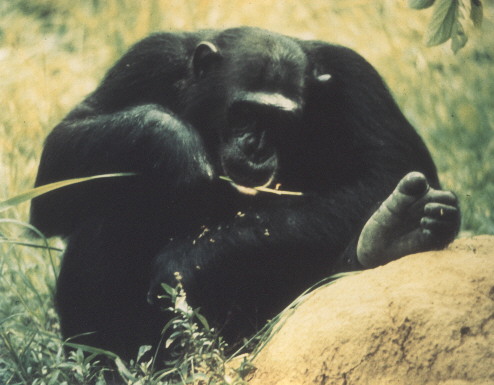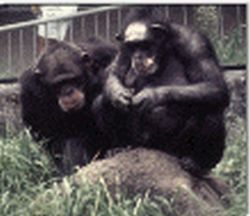Chimpanzees Are a Lot Like Us

We know that chimpanzees
are very much like us. We share common biology, behaviors,
and emotions. For example, chimpanzee DNA (genetic
material) and human DNA are 97.6% similar. In other words,
only 2.4% difference exists between chimpanzee and human
DNA. Chimpanzees are more like humans genetically than
they are like gorillas, another great ape species.
Chimpanzees are
intelligent beings like humans. Their vocal
communications, gestures, and body postures communicate
the mood of complex social interactions. We recognize in
chimpanzee behavior some basic human emotions, such as
fear, distress, annoyance, anger, rage and enjoyment or
contentment. In laboratories, chimpanzees are being taught
to communicate using ASL (American Sign Language of the
Deaf) or a symbolic computer language. Computers are also
used to teach chimpanzees to count.
Tool production and use
is another shared behavior. Wild chimpanzees carefully
select twigs to shape into long slender fishing rods using
their hands, lips and teeth. Using one long finger,
chimpanzees poke a hole in a termite mound, then slowly
insert a fishing rod (a stick or branch they have altered
for this purpose) into the hole. A few seconds later, the
tool is slowly withdrawn covered in termites that have
nasty, painful bites. Using lips and teeth, the
chimpanzees carefully extract the termites and eat the
tasty treat. Chimpanzees of the Tai Forest use rocks as
hammers and anvils to remove nuts from hard shells. Like
humans, chimpanzees use their intelligence to make and use
tools to fit situational and environmental needs.
Captive Chimpanzees

Chimpanzees have large
complex brains and perform sophisticated behaviors. It is
important that they live in environmentally rich habitats
to stimulate mental activity and reduce boredom. In
addition, the use of "enrichment" devices and
activities, novel objects and foods, intellectually
stimulating feeding strategies (such as hiding food in
browse, hidden holes in simulated trees and other
structural objects in the habitat), keep the chimpanzees
occupied. Keepers and volunteers are constantly in search
of new enrichment ideas to add variety to the chimpanzees'
day.

